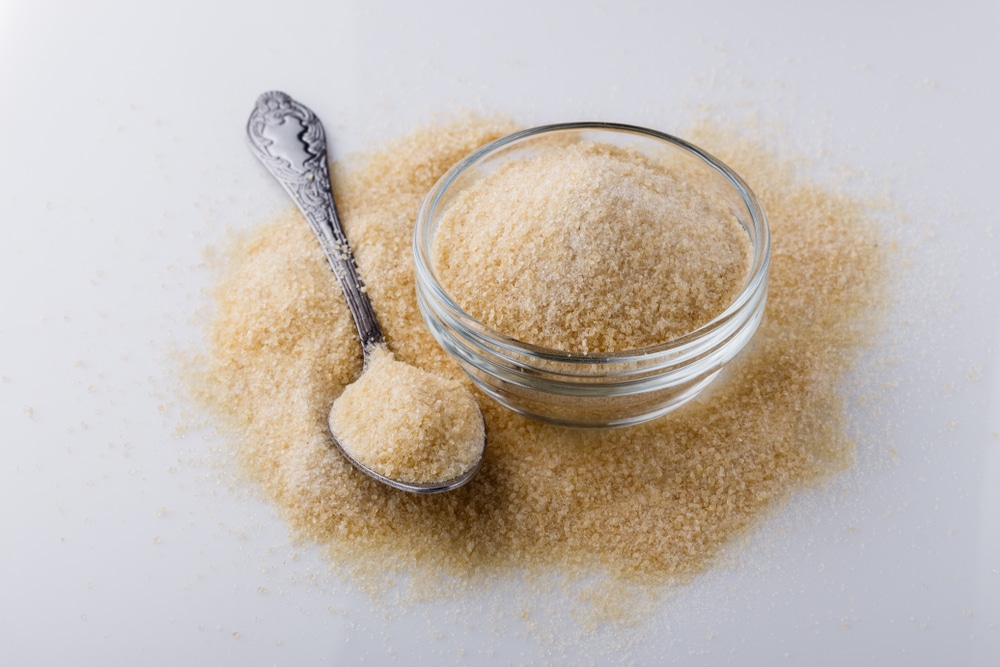Gelatin: The Essential Ingredient That Gives Gummies Their Chewy Texture
Gelatin is a natural, protein-rich substance derived primarily from collagen, found in the connective tissues of animals. It’s a versatile ingredient commonly used in the food industry, particularly in gummy candies, jellies, and marshmallows, to create a unique chewy texture. The origins of gelatin can be traced back to ancient times when people first discovered the gelling properties of collagen by boiling animal bones and skins.
How Gelatin is Made: The Extraction Process
The process of making gelatin involves several key steps, beginning with the collection of raw materials such as the bones, skin, and tendons of animals, typically pigs and cattle. These materials are cleaned, treated, and then subjected to either an acid or alkaline process to extract the collagen. The collagen is then heated and dissolved in water, resulting in a liquid that is filtered, concentrated, and dried into gelatin powder or sheets. This process can be adjusted to produce different types of gelatin for various uses.
Types of Gelatin: Variations and Their Uses
There are several types of gelatin, each suited to specific applications:
- Type A Gelatin: Derived from acid-treated materials, usually pork skin, it is commonly used in food products due to its neutral taste and strong gelling properties.
- Type B Gelatin: Produced through an alkaline process, often from bovine hides, this type is preferred for pharmaceutical uses, such as in capsules.
- Fish Gelatin: Extracted from fish skins, this type is used in products that must meet kosher or halal dietary requirements.
Each type has distinct characteristics, such as gelling strength and melting point, making them suitable for different culinary, pharmaceutical, and industrial applications.
Nutritional Profile of Gelatin
Gelatin is predominantly composed of protein, offering a unique amino acid profile rich in glycine, proline, and hydroxyproline. These amino acids are vital for the maintenance and repair of skin, joints, and connective tissues. Gelatin is low in calories, fat, and carbohydrates, making it a popular ingredient for those on low-calorie or low-carb diets. Additionally, gelatin is free from common allergens and gluten, which makes it an accessible ingredient for a wide range of dietary needs.
Health Benefits of Gelatin
Gelatin’s health benefits are numerous, making it a valuable addition to any diet:
- Joint Health: The high levels of collagen in gelatin support joint cartilage, reducing pain and stiffness in conditions such as osteoarthritis.
- Skin Health: Gelatin promotes skin elasticity and hydration, potentially reducing the appearance of wrinkles and improving overall skin health.
- Digestive Health: Gelatin aids digestion by enhancing gastric juices and helping to maintain the integrity of the gut lining, which can prevent and alleviate conditions like leaky gut syndrome.
Culinary Uses of Gelatin
Gelatin’s ability to form gels makes it a staple in the culinary world:
- Gummies and Marshmallows: Gelatin gives these confections their characteristic chewy texture, essential for their appeal.
- Jellies and Desserts: Gelatin is the key ingredient in creating smooth, set desserts like panna cotta and jelly.
- Thickening Soups and Sauces: Gelatin can be used to add body and richness to soups, sauces, and gravies.
Gelatin in Confectionery: A Sweet Essential
In the world of confectionery, gelatin is indispensable for creating the perfect texture in sweets. Its gelling and stabilizing properties ensure that gummy candies, marshmallows, and other treats maintain their desired consistency. The bloom strength of the gelatin is carefully selected to achieve the right firmness, and its neutral flavor allows the sweet flavors to shine without interference.
Gelatin in Pharmaceuticals: Beyond Food
Gelatin is a critical ingredient in the pharmaceutical industry, particularly in the production of capsules and tablets. Its ability to form a protective barrier around active ingredients makes it ideal for encapsulating drugs, ensuring that they are delivered effectively within the body. Gelatin capsules are preferred for their ease of swallowing and the protection they offer to sensitive ingredients.
Gelatin in Beauty and Cosmetics
Gelatin also finds its way into the beauty and cosmetics industry, where it plays a role in:
- Face Masks: Gelatin is used in peel-off masks for its film-forming properties, helping to remove dead skin cells and impurities.
- Hair Treatments: Its protein content strengthens and conditions hair, making it a popular ingredient in hair masks and treatments.
- Nail Care: Gelatin can strengthen nails and promote growth, offering a natural remedy for brittle nails.
The Science Behind Gelatin’s Gelling Properties
The gelling properties of gelatin are due to its unique molecular structure. When dissolved in hot water, gelatin’s triple-helix collagen structure unwinds into single strands. As the solution cools, these strands re-form into a network that traps water, creating a gel. This gelling process is reversible, meaning gelatin can be melted and re-gelled multiple times without losing its properties. The strength of the gel is measured by its bloom strength, which varies depending on the type of gelatin used.
Gelatin in Diet and Weight Management
Gelatin is a popular ingredient in weight management products due to its high protein content, which can promote satiety and reduce appetite. Consuming gelatin can help with muscle maintenance during weight loss, as well as provide a low-calorie, satisfying addition to various diet plans.
Gelatin for Athletes: Enhancing Performance and Recovery
For athletes, gelatin offers numerous benefits, particularly in muscle recovery and joint health. The collagen in gelatin supports the repair of tendons and ligaments, which are critical for athletic performance. Gelatin supplements can also help prevent injuries and speed up recovery time, making it a valuable addition to an athlete’s diet.
Environmental Impact of Gelatin Production
The production of gelatin has environmental implications, as it is closely tied to the livestock industry. While gelatin production utilizes by-products from meat processing, reducing waste, the sustainability of livestock farming remains a concern. The gelatin industry is increasingly exploring more sustainable practices and sourcing methods to mitigate its environmental impact.
Gelatin’s Global Market and Economic Impact
The gelatin market is a significant global industry, driven by demand in the food, pharmaceutical, and nutraceutical sectors. As consumer interest in health and wellness grows, so too does the market for gelatin. The industry supports economies through its role in agricultural by-product utilization, job creation, and contributions to food security.
Ethical and Cultural Considerations in Gelatin Use
Gelatin’s use and production are influenced by various ethical and cultural considerations:
- Religious and Cultural Restrictions: Gelatin derived from pork is not permissible in certain religions, leading to the development of halal and kosher-certified alternatives.
- Animal Welfare Concerns: Increasing awareness of animal welfare has led to demand for ethically sourced gelatin and transparency in the supply chain.
- Plant-Based Gelatin Alternatives: The rise in plant-based diets has fueled interest in gelatin alternatives like agar-agar, pectin, and carrageenan, which are suitable for vegetarians and vegans.
The Future of Gelatin: Trends and Innovations
The future of gelatin is shaped by consumer preferences, technological advancements, and sustainability efforts. Innovations in sustainable production, the development of hybrid products, and personalized nutrition are likely to drive the industry forward.
Gelatin’s Unstoppable Evolution
Gelatin is far more than just a food ingredient; it is a vital component in various industries, offering numerous benefits ranging from culinary uses to health and beauty applications. As consumer demand for natural, functional ingredients continues to grow, gelatin’s role in our lives will only become more significant. The ongoing evolution of gelatin production, driven by innovation and sustainability, ensures that this versatile ingredient will remain an essential part of our future.
FAQs
Q: What are the main sources of gelatin?
A: Gelatin is primarily derived from the collagen in animal bones, skin, and connective tissues, most commonly from pigs and cattle.
Q: Can gelatin be used in vegan or vegetarian diets?
A: Traditional gelatin is not suitable for vegan or vegetarian diets. However, plant-based alternatives like agar-agar and pectin are available.
Q: How does gelatin benefit joint health?
A: The collagen in gelatin supports the maintenance and repair of joint cartilage, which can help reduce pain and stiffness in conditions like osteoarthritis.
Q: What is bloom strength in gelatin?
A: Bloom strength is a measure of gelatin’s gelling power. Higher bloom strength indicates a firmer gel.
Q: Are there any allergens in gelatin?
A: Gelatin is generally free from common allergens and is gluten-free, making it suitable for a wide range of dietary needs.

